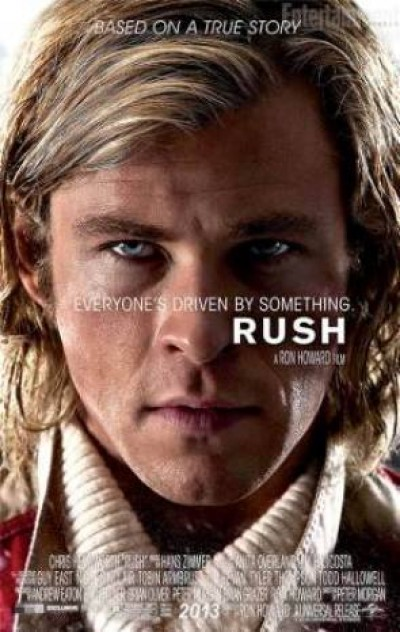“You fat little inbred beauty”
The story of James Hunt (Chris Hemsworth) and Niki Lauda (Daniel Brühl) is one we can all relate too. It’s a tale of two extremes: the easygoing partier with ideas of immortality and the calculating taskmaster who knows the odds and understands the consequences. In keeping with the Formula One spirit cinematically, we could even metaphorically pit Rush‘s Hunt against Senna’s Lauda—the Hollywood pretty boy opposite the riveting documentary—to see how your tastes align with personality. I’m a Lauda, always have and always will be. But just because I can relate to his analytical viewpoint on life doesn’t mean I don’t like to have fun. And while Ron Howard‘s glossy biopic may possess the sheen of mainstream action and manufactured drama to do so, it also contains a naked humanity beneath the facade.
I credit screenwriter Peter Morgan for finding this balance and deciding not to simply tell the James Hunt story despite what you may believe courtesy of Hemsworth’s face filling Rush’s poster. No, the film takes care to ensure that he and Brühl’s Lauda receive equal exposure and care during its depiction of 1976—a year of personal and professional tragedy for both. We get a touch of background exposition to flesh out their rivalry, but nothing more than a necessary psychological study to prove how different their personalities are. It doesn’t take more than their first race in Formula Three to see who is going to take the bigger risks, but as Hunt plays chicken and on the track to win, we can’t help knowing the sport is Lauda’s for the taking.
And it isn’t even because we only receive montages of Hemsworth with a revolving door of naked women—interesting that rising star Natalie Dormer partook in this fun despite having little to do besides nudity—while Brühl turns the gears behind the scenes by trading money and his unparalleled professionalism/ingenuity for a racing contract. At a certain point Hunt’s fearless hubris will be the difference between them after his notoriety and skill earns him a team in McLaren that’s on par with Lauda’s Ferrari technologically. It’s this detail that would make him a force on the tour despite Niki’s superior intellect and dedication. If Hunt slowed down the extracurricular activities to really buy into the work above the sport, he’d be unstoppable. As the story shows, however, that was never his goal.
The dynamic between these two men—or at least their characterizations onscreen—is intriguingly gray as far as protagonist versus antagonist. Both are bullies in their own way and both are sympathetically passionate about winning. While it’s easy to root for Hemsworth being the heart-on-his sleeve combatant against the Austrian robot, watching him constantly pick on the friendless Lauda can easily sway you to the other side. They are also each other’s drive, though, pushing forward to the brink so that they can improve every race until it becomes them against a field sitting a distant third and beyond. But what really makes the story and the film captivating is its central truth that these men ride around those tracks with only an eighty percent chance at best of living. That’s their common enemy.
And boy does it hit them like a ton of bricks in a way that can’t help but show their mutual respect beyond the petty soundbytes and angry competitiveness. Even as someone who knows nothing about racing, I knew the horrible crash that would ultimately come. Just like the inevitable end of Anton Senna and Alain Prost’s rivalry during the 80s and 90s, death and injury lingers over every single action these men take. Whether it’s fate, bad luck, or some warped gift to open one’s eyes to what truly matters, someone is always on the losing end. Unlike Senna’s document of one man’s life and talent, however, Rush’s conclusion won’t finish in accident. Lauda will either repeat as world champion or Hunt will take his first—no amount of fire will change that.
Even for those who know the victor’s identity, though, Howard and his team have created a film worth seeing. Whether it’s the stunningly authentic look and feel of the era through costumes, wardrobe, and hairstyles or the unadulterated depiction of celebrity excess and tabloid glamor, 1976’s Formula One becomes the backdrop for their lives to shine. Above who wins or loses, Hunt and Lauda’s evolution as men and athletes is the main focal point with their juxtaposed styles on the track only providing the tip of the iceberg in comparison with their parallel love lives diverging in accordance to assumptions. While Hunt’s volatility and ego can never let him be a good husband to model Suzy Miller (Olivia Wilde), Lauda’s meticulously planned actions find his love for Marlene (Alexandra Maria Lara) proving stronger than his career.
As the film’s narration and focus shifts between the two, we begin to understand their similarities as well. Strip away their origins and their effort in joining the F-1 circuit and they’re both simply in this game to prove they belong. Hemsworth and Brühl bring their avatars to life when engaged in combat—both playful and real—by showing two sides of the coin for a sport where every athlete has to be at least a little left of sane. They are the men the rest of the field looks to for answers and whose personalities clash in such a way that tragedy does result. And while Howard and Morgan eventually get overly heavy-handed with their characters’ struggle between safety and triumph, the performances and aesthetic make it so few notes ring glaringly false.
Rush: 7/10
Rating: R | Runtime: 123 minutes | Release Date: September 27th, 2013 (US)
Studio: Universal Pictures
Director(s): Ron Howard
Writer(s): Peter Morgan

